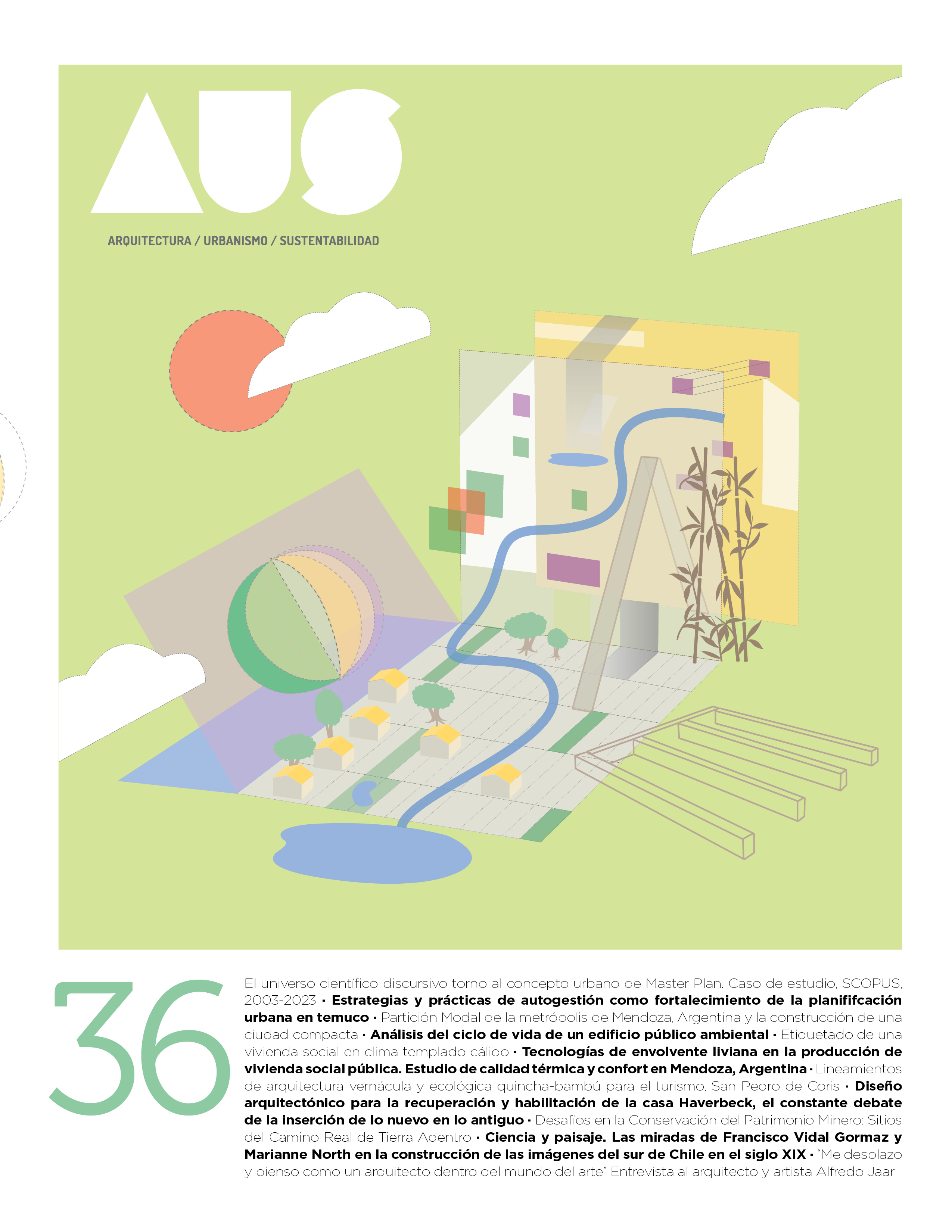Tecnologías de envolvente liviana en la producción de vivienda social pública. Estudio de calidad térmica y confort en Mendoza, Argentina
Conteúdo do artigo principal
Resumo
Tanto a nivel nacional como regional, se observa un creciente uso de sistemas de envolvente liviana opaca en la construcción de vivienda nueva, implementados como tendencia en diferentes contextos socioeconómicos. En el marco de la política pública del Instituto Provincial de Vivienda en Mendoza sobre la construcción y experimentación de viviendas público-estatales desarrolladas con sistemas no convencionales de construcción –como los sistemas de paneles de núcleo aislante revestidos con OSB (paneles SIP), sistema de paneles aislantes y mortero proyectado, y el sistema steel framing– se propone analizar datos pragmáticos de temperatura obtenidos mediante auditorías in situ de seis viviendas, complementadas con las respuestas obtenidas en encuestas de percepción subjetiva (ambiental y de confort) de los usuarios. Los resultados obtenidos indican que, en invierno, el uso de sistemas mecánicos es mesurado: se acciona en horarios clave del anochecer y el amanecer y las viviendas mantienen una temperatura estable. Mientras, en verano se observa que los sistemas mecánicos para enfriar se usan con mayor intensidad con el fin de lograr confort ambiental. Los resultados térmicos interiores mostraron, en términos generales, un sobrecalentamiento de los espacios, situación que resulta favorable en invierno y desfavorable en verano.
Detalhes do artigo

Este trabalho está licenciado sob uma licença Creative Commons Attribution-NonCommercial-NoDerivatives 4.0 International License.
Referências
Andersen, M., Discoli, C., Viegas, G., Martini, I. (2018). Monitoreo energético y estrategias de retrofit para viviendas sociales en clima frío. Revista Hábitat Sustentable Vol. 7, n° 2, 50-63. https://doi.org/10.22320/07190700.2017.07.02.05
Arena, P., Basso, M., Fernández Llano, J. (2006). Análisis comparativo del ciclo de vida de envolventes livianas prefabricadas y pesadas de mampostería para viviendas. Avances en Energías Renovables y Medio Ambiente. Vol. 10, 43-48. https://sedici.unlp.edu.ar/bitstream/handle/10915/87798/Documento_completo.pdf-PDFA.pdf?sequence=1&isAllowed=y
American Society of Heating, Refrigeration and Air-conditioning Engineers, [ASHRAE] (1992). Standard 55-92. Thermal environmental conditions for human occupancy. Atlanta, Georgia, USA.
Balcomb, J.D., Barey, D., McFarland, R., Perry, J., Wray, W., Noll, S. (1982). Passive Solar Design Handbook. Volume two of two volumes: passive solar design analysis. United States: N. p., 1980. doi: 10.2172/5672634
Balter, J., Ganem, C., Discoli, C. (2016). On high-rise residential buildings in an oasis-city: thermal and energy assessment of different envelope materiality above and below tree canopy. Energy and Buildings, 113, 61-73. https://doi.org/10.1016/j.enbuild.2015.11.011
Balter, J., Miranda Gassull, V. M. (2022). Nuevas tecnologías de construcción prefabricada en el hábitat popular. Análisis socioeconómico y térmico para el caso de Mendoza. AREA, 28(2), pp. 1-14. https://area.fadu.uba.ar/wpcontent/uploads/AREA2802/2802_balter_gassull.pdf
Berná, F., Miranda-Gassull, V., Ginestar, F. (2024). Criterios y procedimientos para medir el déficit habitacional en aglomerados intermedios. El caso de la provincia de Mendoza, Argentina. Cuaderno Urbano, 34, Argentina. https://doi.org/10.30972/crn.37377519
Czajkowski, J.D., Diulio, M.P., Ferreyra, M.A. (6 de mayo al 5 de junio, 2019). Módulo pedagógico sustentable y seco. Jornadas de Construcciones Sustentables y Reuniones de Asesoramiento Tecnológico. Ministerio de Ciencia, Tecnología e Innovación. Provincia de Buenos Aires, La Plata. https://sedici.unlp.edu.ar/bitstream/handle/10915/79419/Presentaci%C3%B3n__diapositivas_.pdf-PDFA.pdf?sequence=1&isAllowed=y
Donald, C., Ghisi, E. (2011). The influence of the envelope on the thermal performance of ventilated and occupied houses. Energy and Building, vol. 43, nº 12, 3391-3399. https://doi.org/10.1016/j.enbuild.2011.09.001
Esteves, A. Gelardi, D., Oliva. (1997). The shape in the Bioclimatic Architecture: The FAEP Factor. Proceedings of 2nd Teachers in Architecture Conference (TIA), Florencia, Italia.
Filippín, C., Flores Larsen, S., Flores, L. (2007). Comportamiento energético de verano de una vivienda másica y una liviana en la región central de Argentina. Avances en Energías Renovables y Medio Ambiente. Vol. 11, 17-23. http://sedici.unlp.edu.ar/bitstream/handle/10915/92743/Documento_completo.pdf-PDFA.pdf?sequence=1&isAllowed=y
Flores-Larsen, S., Filippin, C., Lesino. G. (2001). Simulación mediante Simedif y Energy-10 de un edificio liviano. Avances en Energías Renovables y Medio Ambiente. Vol. 5, 25-30. http://sedici.unlp.edu.ar/bitstream/handle/10915/79818/Documento_completo.pdf-PDFA.pdf?sequence=1&isAllowed=y
Givoni, B. (1998). Climate Considerations in Building and Urban Design. New York: Van Nostrand Reinhold, 1998.
Instituto Nacional de Estadística y Censos-INDEC, (2010). Censo Nacional de Población, Hogares y Viviendas 2010. https://www.indec.gob.ar/
Marincic I., Ochoa J.M., del Rio, J. (2012). Confort térmico adaptativo dependiente de la temperatura y la humedad. ACE: Arquitectura, Ciudad y Entorno (en línea). Año 7, pp 27-46. https://doi.org/10.5821/ace.v7i20.2572
Mercado, M.V., Barea Paci, G., Esteves, A., Filippín C. (2018). Efecto de la ventilación natural en el consumo energético de un edificio bioclimático. Análisis y estudio mediante energy plus. Revista Hábitat Sustentable Vol. 8, n°. 1, 54-67. https://doi.org/10.22320/07190700.2018.08.01.05
Miranda-Gassull, V. y Ginestar, F. (2023). El fenómeno de la inquilinización en las ciudades intermedias: actores, valores y oferta inquilina en el Área Metropolitana de Mendoza, Argentina. Perspectiva Geográfica, 28(2): 1. https://doi.org/10.19053/01233769.14479
Oke, T. R. (2004). Initial guidance to obtain representative meteorological observations at urban sites (Vol. 81, p. 51). Geneva: World Meteorological Organization.
Olgyay, V. (2015). Design with Climate: Bioclimatic Approach to Architectural Regionalism. US: Princeton University Press.
San Juan, G., Viegas, G., Jodra, J. (2018). Aislación térmica alternativa, reutilizando poliestireno expandido de descarte, orientado a las necesidades de cooperativas de reciclado. Décimo Congreso Regional de Tecnología en Arquitectura (CRETA), La Plata, Argentina. http://sedici.unlp.edu.ar/bitstream/handle/10915/71329/Documento_completo.pdf-PDFA.pdf?sequence=1&isAllowed=y
Thomas, H. (2012). Tecnologías para la inclusión social en América Latina: de las tecnologías apropiadas a los sistemas tecnológicos sociales. Problemas conceptuales y soluciones estratégicas. En: Thomas, H. Fressoli M., Santos G. Tecnología, desarrollo y democracia: nueve estudios sobre dinámicas socio-técnicas de exclusión / inclusión social. Ministerio de Ciencia, Tecnología e Innovación Productiva de la Nación.
Toledo, V. (2020). ¿De qué hablamos cuando hablamos de Sustentabilidad? Revista Internacional de salarios dignos, 1(02): 61-85. https://revistasinvestigacion.lasalle.mx/index.php/OISAD/article/view/2554
Venhaus, M., Alías, H., Jacobo, G. (2016). Las envolventes constructivas en la construcción no convencional de edificios del nordeste argentino y el problema de los puentes térmicos. Revista Hábitat Sustentable, Vol. 7, N° 1, 24-31. https://revistas.ubiobio.cl/index.php/RHS/article/view/2619

